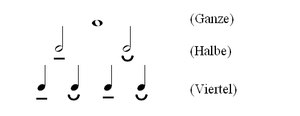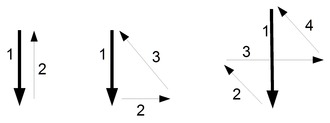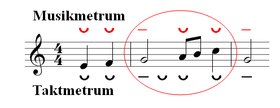Meter (music)
Metrics as the science of meter in language and music is not an exact natural science , but a logical spiritual science . Under meter (Gr. Μέτρον métron , in general: measure, measure, especially: syllable and meter ) - in the narrower sense - the weight or stress ratios ( accentuation ), in the language of words and sentences, in the music of these corresponding designs and phrases understood by the mental semantic content or meaning of this molded structure ( figures is made) for expression.
In language, the concept of meter is based - in the broader sense - on its meaning as a syllable measure. Firstly, the quantitative length (quantifying metric) that cannot be precisely determined is measured, and secondly, the qualitative weight (accentuating metric) of the syllables in the natural word and in the artificial verse, which is determined by the word meaning.
In the melodic dimension of music, the temporal succession of different tone durations forms the rhythm and the structure of emphasis (weighting) of the tones within formal formations (i.e. not the simple succession of different tone strengths) the meter. The duration of the sound is an exact measure of time, the strength of the sound an exact measure of oscillation (amplitude); The (metric) tone weight, on the other hand, is an ideal value that is assigned to a tone due to its ranking relationship to at least one other tone.
theory
Music metric and language metric
Language and music only appear fully in their differentiating and evaluating sound or sound form, which is actually the metric one. The theory must therefore primarily take on the real, i.e. sounding forms of word and sentence or motif and phrase , otherwise it operates with empty terms. The higher form formations such as verse, stanza, period, etc., are artificial structures that do not belong to metrics, but to verse theory in language and to form theory in music .
The Sprachmetrum is bound to the lexical defined word, the syllable weight is combined with the meaning of words (for example: al le and Al lee , on set and on set). The grammatical hyphenation mostly disregards this fact (examples: help, wrestling). In music, the formal units of meaning to which the meter is bound (figure, tone syllable, motif, phrase) are neither known a priori, nor can they be clearly derived from the musical text or spontaneously from the music. They have to be found or determined through artistic, that is, consciously intuitive analysis.
Music-metric terms and signs
There are two polar metric values or elements: a tone (or a short sequence of tones) is difficult (stressed) or light (unstressed). A stressed tone is called heaviness or elevation (sign: -), an unstressed tone is called lightness or lowering (sign: ‿), derived from the raising and lowering of the voice. Regarding the ancient Greek terms Arsis and Thesis sd The metric elements can still be differentiated, in the notation they are then given an accent mark.
A musical meter of a certain form is called a sound foot, based on the model of word foot and verse foot. The most important are: Trochäus - ‿, Iambus ‿ -, Dactylus - ‿ ‿, Amphibrachys ‿ - ‿, Anapäst ‿ ‿ -, First - ‿ ‿ ‿ to Fourth Päon ‿ ‿ ‿ -.
Meter and Time
The 'clock' is used for the notation of the meter, it is a faithful representation of the metric system. It is not heard directly in the music, but resides virtually in it. If you want to capture it consciously, you have to join in by counting, knocking, beating the clock or dancing.
The complete term includes: 1. the even basic beat (beat, beat part, counting time; examples: pulse beat); 2. a grade value as the relative duration of the basic beat; 3. the number of basic beats that determine the length of the measure; and 4. the stress pattern or meter of these basic beats, the first of which, the 'one', represents the severity of the beat.
Meter and rhythm
The rhythm is a vital-temporal, the meter a mental-timeless principle of music, the former forms the substructure, the latter the superstructure. The melodic course of movement is based on a perfect, mathematically founded rhythmic system. The relative duration of tones and pauses, whole, half, quarter, eighth etc., which are linked to their graphic form in the notation, are theoretically described as hierarchically arranged time value levels. The main level is indicated in the time signature. In the sounding music, but you can experience the holistic rhythm ( ῥυθμός rhythmos "rhythm", clock, symmetry, regularity), the so-called levels exist only conceptually..
This exact rhythmic system forms the material basis for the non-quantifiable metric system, in that a certain tone duration becomes the measure of time for the individual metric element (raising or lowering) and a certain number of tones becomes the accentuation pattern of the measure.

The music in its sound form has its own organic structure, which is formed by the rhythmically and metrically constituted forms, according to which the underlying clock model is also set up.
Meter and form
Abstract forms, meters , can be derived from the clock meter . The two bar provides the trochaeus and iambus, the three bar the dactyl, anapast and amphibrachys, the four bar the four peons. In the music that sounds , these meters become sound feet due to their artistic, particularly rhythmic form .

If a bar part is divided rhythmically, a further time value level becomes active so that a third sound foot can be derived, e.g. E.g. if a quarter note becomes two eighth notes in two-bar:

And vice versa, a double note value leads to the omission of a metric element and thus a sound foot.
practice
Tact
The notated measure provides an optically clear picture of the metric system on which a piece of music is based . The denominator of the bar break denotes the individual beat duration, the numerator the number of these durations (per bar), and the bar line denotes the first beat as heavy and thus the others as light. The most common time signatures are the two or binary , the three or ternary and the four or quaternary time.

The beat figures of the choir and orchestra conductors also make the beat visible:

Time meter and rhythm
The 'beat' can already be changed by the rhythm alone, so a distinction must always be made between the theoretical, rigid meter of the clock scheme and the resounding, continuously changing meter of the music:

syncope
A tension or friction between the beat meter and the music meter leads to so-called syncope (from gr. Συν-κοπτειν syn-koptein , to strike, to bump together), which is of different strength depending on the position in the beat. In the following example, the heavy syllable [un-] on bar one is increased to the actually easy bar three. This is explained by the fact that the following, difficult bar one is shifted back to bar three; in reality, however, it is always the motif that sets the word "not understood" to music that determines the beat, and not the beat that determines the motif. Rhythmic formations should also not be included in the syncope term, otherwise it will be watered down. Musical syncope is a purely metric phenomenon.

Motive and phrase meter
The meter is inextricably linked to the musical formations of the figures, motifs, phrases and themes, in which, in addition to the sensory pitch order and the vital rhythm, the ideal content of the music is expressed, which of course is not of a conceptual but of a tonal nature. There are no binding characters for the notation of these formations. But if the melody is only subjected to the beat meter, it can be distorted beyond recognition.
In vocal music, the problem can be solved from the text: the word meter is binding for the setting. Deviations between language and music metrics are part of the artistic nature of the matter. At the beginning of the following Schubert song, the three metric levels at hand, the time meter, the language meter and (red) the music meter, are shown.

On the fugue theme in C major from the Well-Tempered Clavier II by JS Bach, it is shown how the motifs are extracted from the musical text in terms of scope and meter. They are formally designated with a bracket and metric within the bracket. The theme that a phrase represents consists of two different motifs, the first can also be understood as having two syllables, the second, which takes up the beginning of the first (the first syllable), is repeated one level higher with little change (sequence). The first motif obeys the rhythm, the two following override it. Of course, all of this has to be expressed audibly, otherwise it will be played badly or incorrectly

Component theory
Another conception of meter is represented by the component theory introduced by Peter Petersen . It explains the sensation of weight from the interaction of primary and secondary durations or rhythms. If there are several rhythmically relevant sound events per point in time in one- or more-part music, a rhythmic weight arises from this. The sequence of graduated rhythmic weights can converge with the accent ratios of conventional time signatures. Seen in this way, their accent patterns are not abstract, but concrete. Their effect is not based on volume, but on the density of events.
literature
- Peter Benary: Rhythm and Metrics. A practical guide (= Musik-Taschen-Bücher. Theoretica. 7 = TB. 254). 2nd Edition. Musikverlag Gerig, Cologne 1973, ISBN 3-89007-004-3 .
- Walther Dürr , Walter Gerstenberg : Rhythm, meter, beat. In: Friedrich Blume (Hrsg.): The music in past and present (MGG). First edition, Volume 11 (Rasch - Schnyder von Wartensee). Bärenreiter / Metzler, Kassel et al. 1963, DNB 550439609 , Sp. 383-419
- Robert Jourdain: The well-tempered brain. How music arises and works in the head. Spectrum - Akademischer Verlag, Heidelberg et al. 1998, ISBN 3-8274-0224-7 .
- Otto Paul: German metric. 3rd, increased and improved edition. Hueber, Munich 1950.
- Peter Petersen : Music and Rhythm. Basics, history, analysis . Schott, Mainz 2010 (English, extended edition: Music and Rhythm. Fundamentals - History - Analysis . Peter Lang, Frankfurt am Main 2013).
- Egon Sarabèr: Method and Practice of Music Design . Papierflieger-Verlag, Clausthal-Zellerfeld 2011, ISBN 978-3-86948-171-5 .
- Egon Sarabèr: The Art of Reading Notes . For beginners and advanced. 2nd, improved edition 2018, Papierflieger-Verlag, Clausthal-Zellerfeld, ISBN 978-3-86948-626-0 .
- Manfred Spitzer : Music in the head. Listening, making music, understanding and experiencing in the neural network. 2nd Edition. Schattauer, Stuttgart 2014, ISBN 978-3-7945-2940-7 .
